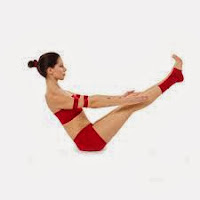Two words strike fear into the heart chakra of even the most courageous yogis: Back pain. You've heard it before — a strong core is key to minimizing injuries and enabling you to take yoga practice to the next level. But should the pangs of back pain strike, redirecting your focus on core strengthening movements could be the answer. Your core muscles — specifically your abdominal, chest and back muscles — support the spine from the lower to the upper back. Core body strength and wellness is so essential to spinal health that spine experts at Community Wellness Blog even recommend therapeutic yoga postures for patients recovering from back surgery. So before surgery becomes the only viable option, take on back pain with these top four yoga poses for core conditioning.
One caveat: If you are experiencing chronic back pain, consult your physician before performing these poses.
Image via RelaxingMusic via Flickr.
Side Plank Pose (Vasisthasana)
 While arm strength is the focal point of this pose, the abdominal muscles work to stabilize the body, particularly the obliques. From plank position, shift your weight onto your right arm and the side of your right foot. Stack your left foot on top of your right foot and raise your left arm toward the ceiling, lifting your gaze to the left fingertips. Hold for three to five breaths and repeat on the
While arm strength is the focal point of this pose, the abdominal muscles work to stabilize the body, particularly the obliques. From plank position, shift your weight onto your right arm and the side of your right foot. Stack your left foot on top of your right foot and raise your left arm toward the ceiling, lifting your gaze to the left fingertips. Hold for three to five breaths and repeat on the alternate side.
Beginner variation: Keep your right knee on the ground as you shift your weight. Position your left foot on the floor with toes turned slightly inward. Advanced variation: From the full pose, lift your left foot so that it hovers above the right.
Half Moon Pose (Ardha Chandrasana)
Half moon pose strengthens the abdomen and spine while stretching the chest, shoulders and legs. From a right side lunge position, bring your left hand to your waist. Place your right fingertips about a foot in front of your right big toe while straightening your right leg and lifting your left leg parallel to the floor. Hold for three to five breaths and repeat on the other side.Beginner variation: Rather than reaching all the way to the floor, use a block to support your hand. Advanced variation: Bend the knee of the lifted leg and reach your hand around to meet your ankle.
Boat Pose (Navasana)
 An intense move for the entire core, boat pose strengthens the key muscles of the back, abdomen and hip flexors. From a seated position, bring the legs straight up to a 45-degree angle while keeping the spine straight. Bring the arms out parallel to the floor. Hold for 10 seconds with the goal of gradually
An intense move for the entire core, boat pose strengthens the key muscles of the back, abdomen and hip flexors. From a seated position, bring the legs straight up to a 45-degree angle while keeping the spine straight. Bring the arms out parallel to the floor. Hold for 10 seconds with the goal of gradually holding for a minute.
Beginner variation: Bend your knees so that your shins are parallel to the floor. Hold the backs of your thighs for support if necessary. Advanced variation: From full boat pose, lower the legs to the floor and hover, keeping the back straight. Lift the legs back up to boat pose and repeat at least twice.
Locust Pose (Salabhasana)
 Locust pose focuses on strengthening the muscles of the spine while stretching the chest, belly and legs. Lying on your belly with your forehead resting on the mat, bring hands alongside your body. Extend your legs straight behind you while lifting your torso and arms straight behind you. Hold for at least three breaths, building up to 1 minute. Rest on alternating cheeks between holds.
Locust pose focuses on strengthening the muscles of the spine while stretching the chest, belly and legs. Lying on your belly with your forehead resting on the mat, bring hands alongside your body. Extend your legs straight behind you while lifting your torso and arms straight behind you. Hold for at least three breaths, building up to 1 minute. Rest on alternating cheeks between holds.Beginner variation: Keep your hands on the floor under your shoulders as you lift your legs. A half locust as shown to left raises one leg at a time; also a great choice for beginners. Advanced variation: Clasp your hands behind you as you hold. (Please note that the picture to the left shows a man performing a half locust pose rather than full because he only has one leg up rather than both at once as in a standard locust pose).




